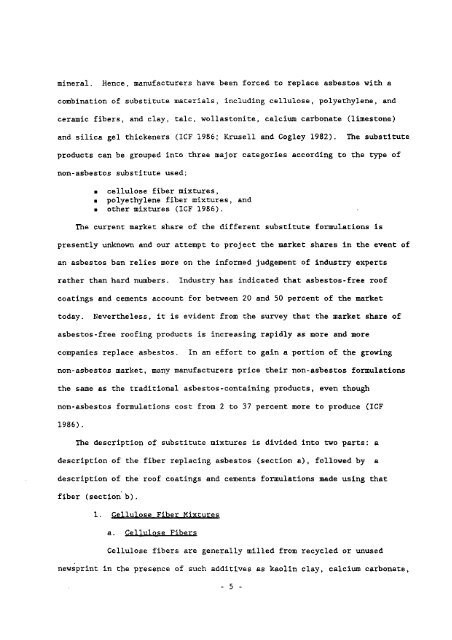Gaskets are materials used to seal one compartment of a device ...
Gaskets are materials used to seal one compartment of a device ...
Gaskets are materials used to seal one compartment of a device ...
You also want an ePaper? Increase the reach of your titles
YUMPU automatically turns print PDFs into web optimized ePapers that Google loves.
mineral. Hence, manufacturers have been forced <strong>to</strong> replace asbes<strong>to</strong>s with a<br />
combination <strong>of</strong> substitute <strong>materials</strong>, including cellulose, polyethylene, and<br />
ceramic fibers, and clay, talc, wollas<strong>to</strong>nite, calcium carbonate (limes<strong>to</strong>ne)<br />
and silica gel thickeners (ICF 1986; Krusell and Cogley 1982). The substitute<br />
products can be grouped in<strong>to</strong> three major categories according <strong>to</strong> the type <strong>of</strong><br />
non-asbes<strong>to</strong>s<br />
substitute <strong>used</strong>:<br />
a cellulose fiber mixtures,<br />
a polyethylene fiber mixtures, and<br />
a other mixtures (ICF 1986). -<br />
The current market sh<strong>are</strong> <strong>of</strong> the different substitute formulations is<br />
presently unknown and our attempt<br />
an asbes<strong>to</strong>s ban relies more on the<br />
<strong>to</strong> project the market sh<strong>are</strong>s in the event <strong>of</strong><br />
informed judgement <strong>of</strong> industry experts<br />
rather than hard numbers.<br />
Industry has indicated that asbes<strong>to</strong>s-free ro<strong>of</strong><br />
coatings and cements account for between 20 and 50 percent <strong>of</strong> the market<br />
<strong>to</strong>day. Nevertheless, it is evident from the survey that the market sh<strong>are</strong> <strong>of</strong><br />
asbes<strong>to</strong>s-free ro<strong>of</strong>ing products is<br />
increasing rapidly as more and more<br />
companies replace asbes<strong>to</strong>s. In an effort <strong>to</strong> gain a portion <strong>of</strong> the growing<br />
non-asbes<strong>to</strong>s market, many manufacturers price their non-asbes<strong>to</strong>s formulations<br />
the same as the traditional asbes<strong>to</strong>s-containing products, even though<br />
non-asbes<strong>to</strong>s formulations cost from 2 <strong>to</strong> 37 percent more <strong>to</strong> produce (ICF<br />
1986).<br />
The description <strong>of</strong> substitute mixtures is divided in<strong>to</strong> two parts: a<br />
description <strong>of</strong> the fiber replacing asbes<strong>to</strong>s (section a), followed by a<br />
description <strong>of</strong> the ro<strong>of</strong> coatings and cements<br />
formulations made using that<br />
fiber<br />
(section b).<br />
1. Cellulose Fiber Mixtures<br />
a. Cellulose Fibers<br />
Cellulose fibers <strong>are</strong><br />
generally milled from recycled or un<strong>used</strong><br />
newsprint in the presence <strong>of</strong> such additives as kaolin clay, calcium carbonate,<br />
-5-
















